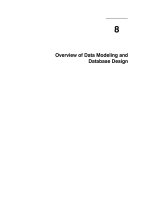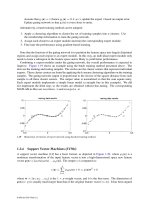Tài liệu Handbook of Dairy Foods and Nutrition, Second Edition ppt
Bạn đang xem bản rút gọn của tài liệu. Xem và tải ngay bản đầy đủ của tài liệu tại đây (8.02 MB, 414 trang )
© 2000 by CRC Press LLC
Handbook of
Dairy Foods and
Nutrition,
Second Edition
National Dairy Council®
Rosemont, Illinois
Gregory D. Miller, Ph.D., F.A.C.N.
Judith K. Jarvis, M.S., R.D., L.D.
Lois D. McBean, M.S., R.D.
8731_fm_frame.FM5.fm Page 1 Friday, November 15, 2002 8:05 PM
© 2000 by CRC Press LLC
Library of Congress Cataloging-in-Publication Data
Miller, Gregory D.
Handbook of dairy foods and nutrition/ Gregory D. Miller, Judith
K. Jarvis, Lois D. McBean. — 2nd ed.
p. cm. — (Modern nutrition)
Includes bibliographical references and index.
ISBN 0-8493-8731-0 (alk. paper)
1. Dairy products in human nutrition Handbooks, manuals, etc.
I. Jarvis, Judith K. II. McBean, Lois D. III. Title. IV. Series:
Modern nutrition (Boca Raton, Fla.)
QP144.M54M55 1999
613.2′6—dc21 99-32183
CIP
This book contains information obtained from authentic and highly regarded sources. Reprinted
material is quoted with permission, and sources are indicated. A wide variety of references are listed.
Reasonable efforts have been made to publish reliable data and information, but the author and the
publisher cannot assume responsibility for the validity of all materials or for the consequences of their use.
Neither this book nor any part may be reproduced or transmitted in any form or by any means,
electronic or mechanical, including photocopying, microfilming, and recording, or by any information
storage or retrieval system, without prior permission in writing from the publisher.
All rights reserved. Authorization to photocopy items for internal or personal use, or the personal or
internal use of specific clients, may be granted by CRC Press LLC, provided that $.50 per page
photocopied is paid directly to Copyright Clearance Center, 27 Congress Street, Salem, MA 01970 USA.
The fee code for users of the Transactional Reporting Service is ISBN 0-8493-8731-0/00/$0.00+$.50.
The fee is subject to change without notice. For organizations that have been granted a photocopy license
by the CCC, a separate system of payment has been arranged.
The consent of CRC Press LLC does not extend to copying for general distribution, for promotion,
for creating new works, or for resale. Specific permission must be obtained in writing from CRC Press
LLC for such copying.
Direct all inquiries to CRC Pres LLC, 2000 Corporate Blvd., N.W., Boca Raton, Florida 33431.
© 2000 by CRC Press LLC
No claim to original U.S. Government works
International Standard Book Number 0-8493-8731-0
Library of Congress Card Number 99-32183
Printed in the United States of America 1 2 3 4 5 6 7 8 9 0
Printed on acid-free paper
8731_fm_frame.FM5.fm Page 2 Friday, November 15, 2002 8:05 PM
© 2000 by CRC Press LLC
Series Preface
The CRC Series in Modern Nutrition is dedicated to providing the widest pos-
sible coverage of topics in nutrition. Nutrition is an interdisciplinary, interprofes-
sional field par excellence. It is noted by its broad range and diversity. We trust the
titles and authorship in this series will reflect that range and diversity.
Published for a broad audience, the volumes in the CRC Series in Modern
Nutrition are designed to explain, review, and explore present knowledge and recent
trends, developments, and advances in nutrition. As such, they will appeal to pro-
fessionals as well as the educated layman. The format for the series will vary with
the needs of the author and the topic, including, but not limited to, edited volumes,
monographs, handbooks, and texts.
Contributors from any bona fide area of nutrition, including the controversial,
are welcome.
I welcome the contribution of the book Handbook of Dairy Foods and Nutrition,
Second Edition by my talented and energetic colleagues Gregory D. Miller, Ph.D.,
F.A.C.N., Judith K. Jarvis, M.S., R.D., L.D., Lois D. McBean, M.S., R.D. The first
edition proved extremely useful and we have received lots of positive feedback. It
serves as a resource for those interested in nutritional and clinical aspects of milk
and milk products. The second edition is again timely, up-to-date, and covers an
important subject area.
Ira Wolinsky, Ph.D.
University of Houston
Series Editor
8731_fm_frame.FM5.fm Page 3 Friday, November 15, 2002 8:05 PM
© 2000 by CRC Press LLC
Introduction
America’s dairy farmers participate in a national check-off program that provides
monies to promote the consumption of dairy foods. A large portion of these funds
is used to support nutrition research, communication, and education. Since 1915,
the National Dairy Council® has been committed to establishing programs and
developing educational materials based on current scientific research, as well as
providing sound scientific information in all of its communications.
This book is an update of the first edition of the Handbook of Dairy Foods and
Nutrition. We have again attempted to review the most current scientific information
available on the role and value of dairy foods in a healthful diet. It is a part of our
ongoing effort to provide up-to-date information on foods and nutrition research to
health professionals, educators, consumers, processors, and other interested groups.
We hope this new edition will continue to be a useful resource on the role of dairy
foods in health and nutrition.
8731_fm_frame.FM5.fm Page 4 Friday, November 15, 2002 8:05 PM
© 2000 by CRC Press LLC
The Authors
Gregory D. Miller, Ph.D., F.A.C.N., is vice presi-
dent, nutrition research for National Dairy Council®
(NDC), Rosemont, Illinois. Dr. Miller graduated in
1978 from Michigan State University with a B.S. degree
in nutrition and in 1982 earned an M.S. degree in nutri-
tion (toxicology) from The Pennsylvania State Univer-
sity. In 1986 he received a Ph.D. in Nutrition (toxicol-
ogy) from The Pennsylvania State University.
He served as an undergraduate research assistant in
nutrition-toxicology at Michigan State University in
1978 and was a graduate research assistant in the Center
for Air Environment Studies and the Nutrition Depart-
ment of The Pennsylvania State University from 1979 to 1986. Dr. Miller was a
research scientist for Kraft, Inc., Glenview, Illinois from 1986 to 1989 and was a
senior research scientist from 1989 to 1992.
Dr. Miller is a member of the American College of Nutrition, The American
Society for Nutritional Sciences, The American Society for Clinical Nutrition, Institute
of Food Technologists Nutrition Division, the American Dairy Science Association,
and the International Society for the Study of Fatty Acids and Lipids. He was a
scientific advisory panel member for the Office of Technology Assessment for the
development of several reports to Congress on issues in the treatment and prevention
of osteoporosis. He has chaired or co-chaired more than 20 workshops and symposia
for national organizations including the American Society for Nutritional Sciences,
American College of Nutrition, and the International Life Sciences Institute.
Dr. Miller is a member of the Editorial Board for the Journal of the American
College of Nutrition and Mature Medicine Canada. He has served as a symposium
editor for the Journal of Nutrition and the Journal of the American College of Nutrition.
He is an editorial advisor for Prepared Foods and Dairy Foods magazines. He has
served as a member of the board of directors and is secretary treasurer for the American
College of Nutrition. He is currently a board member of the United States National
Committee to the International Dairy Federation and is president of the International
Dairy Federation’s Commission on Science, Nutrition, and Education.
Among other awards, he has received the 1989 Kraft Basic Science Award and
was listed in the 1992 American Men and Women of Science and the 1992 Who’s
Who in Science. In 1993, Dr. Miller was elected as a Fellow of the American College
of Nutrition. He was selected as an outstanding alumnus by the Michigan State
University in 1996, and received the Health and Human Development Alumni
Recognition Award in 1996 from The Pennsylvania State University.
Dr. Miller has presented more than 65 invited lectures at national and interna-
tional meetings and has published more than 85 research papers, reviews, articles,
and abstracts. He has co-edited three books on diet, nutrition, and toxicology and
contributed chapters to eight books. He is co-author of the Handbook of Dairy Foods
and Nutrition.
8731_fm_frame.FM5.fm Page 5 Friday, November 15, 2002 8:05 PM
© 2000 by CRC Press LLC
Lois McBean, M.S., R.D., is a nutrition consultant
for National Dairy Council. She is the author/editor of
NDC’s Dairy Council Digest, a bimonthly review of
nutrition research for health professionals.
Lois McBean received a B.A. degree in 1966 from
the University of Toronto, and obtained her M.S.
degree in nutrition in 1968 from Cornell University.
Lois is a registered dietitian and an active member of
The American Dietetic Association, The American
Society for Nutritional Sciences, and The Institute of
Food Technology.
Prior to her career as a nutrition writer/editor and
consultant, Lois McBean was a research nutritionist for the federal government in
Washington, D.C., where she was involved in the establishment of zinc as an essential
nutrient. Lois has written extensively on many diet and health issues, especially
those related to the dairy industry. In addition to newsletters, she has authored
numerous articles in peer-reviewed scientific journals, chapters in food and nutrition
books, scientific backgrounders, fact sheets, educational materials (e.g., the Calcium
Counseling Resource), speeches, video conference scripts, and press releases. The
Dairy Council Digest and the Calcium Counseling Resource can be obtained by
logging onto www.nationaldairycouncil.org.
8731_fm_frame.FM5.fm Page 6 Friday, November 15, 2002 8:05 PM
© 2000 by CRC Press LLC
Judith K. Jarvis, M.S., R.D., L.D., is manager of
consumer and health professional information in the
nutrition research department of the National Dairy
Council. In this position, she writes scientific back-
ground papers, develops other educational pieces for
health professionals, and manages quarterly mailings
to the nutrition and health community. Judy monitors
major medical/nutrition journals and writes or reviews
summaries of current research for dissemination to
local Dairy Councils and other dairy industry organi-
zations. In addition, she reviews materials for technical
accuracy from a variety of departments and develops
corporate comments provided to regulatory agencies as
needed. Judy also answers technical inquiries related to dairy foods, nutrition, and
health from local Dairy Councils, health professionals, the dairy and food industry,
educators, government agencies, and consumers.
Judith Jarvis earned a bachelor of science degree in communications from the
University of Illinois and a master of science degree in human nutrition and nutri-
tional biology from the University of Chicago.
Prior to joining the National Dairy Council, she worked as a clinical dietitian,
providing nutritional care and education to cardiac and renal patients. She is a
member of The American Dietetic Association, the American College of Nutrition,
and is current President of the Chicago Nutrition Association. She served as editor
of the American College of Nutrition newsletter from 1995-1998 and has authored
articles for scientific and nutrition journals.
8731_fm_frame.FM5.fm Page 7 Friday, November 15, 2002 8:05 PM
© 2000 by CRC Press LLC
Chapter Reviewers
Chapter 1
The Importance of Milk and Milk Products in the Diet
Robert G. Jensen, Ph.D.
Manfred Kroger, Ph.D.
Chapter 2
Dairy Foods and Cardiovascular Health
Ronald M. Krauss, M.D.
David Kritchevsky, Ph.D.
Chapter 3
Dairy Foods and Hypertension
David A. McCarron, M.D.
Michael Zemel, Ph.D.
Chapter 4
Dairy Foods and Colon Cancer
Martin Lipkin, M.D.
Michael J. Wargovich, Ph.D.
Chapter 5
Dairy Foods and Osteoporosis
Robert P. Heaney, M.D.
Connie M. Weaver, Ph.D.
Chapter 6
Bone Health and the Vegetarian
Robert P. Heaney, M.D.
Connie M. Weaver, Ph.D.
Chapter 7
Dairy Foods and Oral Health
William H. Bowen, D.D.S., Ph.D.
Dominick P. DePaola, D.D.S., Ph.D.
Chapter 8
Lactose Intolerance
Dennis A. Savaiano, Ph.D.
Michael Levitt, M.D.
Chapter 9
Contribution of Milk and Milk Products to Health throughout the Life Cycle
Connie M. Weaver, Ph.D.
Susan I. Barr, Ph.D., R.D.N.
8731_fm_frame.FM5.fm Page 8 Friday, November 15, 2002 8:05 PM
© 2000 by CRC Press LLC
Acknowledgments
We would like to thank and acknowledge the many people who have provided
support in the development of this book. Special thanks are given to Laurel Fantis
for help with preparation of manuscripts and obtaining permission for reproducing
figures and tables; Nancy Warner for help in preparing tables and graphs and for
word processing assistance; and Marya Spangler for help with literature searches
and collecting data.
Two experts reviewed each chapter. A list of the chapters and reviewers is
provided. We thank them for their helpful suggestions in the preparation of each
chapter.
8731_fm_frame.FM5.fm Page 9 Friday, November 15, 2002 8:05 PM
© 2000 by CRC Press LLC
Contents
Chapter 1
The Importance of Milk and Milk Products in the Diet
I. Introduction
II. Recommendations to Include Milk and Milk Products in the Diet
A. Food Guide Recommendations
B. Government Feeding Programs/Child Nutrition Programs
III. Contribution of Milk and Milk Products to Nutrient Intake
A. Nutrient Contribution
B. Milk and Milk Products throughout Life
C. Low Intake of Dairy Foods Compromises Nutrient Intake
IV. Nutrient Components of Milk and Milk Products
A. Energy
B. Protein
C. Carbohydrate
D. Fat
E. Vitamins
F. Minerals
V. Protecting the Quality of Milk and Other Dairy Foods
A. Who is Responsible for Milk’s Quality?
B. Pasteurized Milk Ordinance
C. Unintentional Microconstituents
D. Milk Treatments
E. Storage and Handling
VI. Kinds of Milk and Milk Products
A. Consumption Trends
B. Wide Range of Milk and Milk Products
C. Chocolate Milk
D. Cheese
E. Cultured and Culture-Containing Dairy Foods
F. Whey Products
VII. Summary
References
Chapter 2
Dairy Foods and Cardiovascular Health
I. Introduction
II. Contribution of Milk and Milk Products to Fat and Cholesterol Intake
III. Dairy Nutrients, Dairy Foods, and CHD
A. Single Nutrients
1. Dietary Fatty Acids
2. Dietary Fat Quantity
3. Dietary Cholesterol
4. Protein (Casein)
8731_fm_frame.FM5.fm Page 10 Friday, November 15, 2002 8:05 PM
© 2000 by CRC Press LLC
5. Vitamin D
B. Genetics
C. Dairy Foods
1. Milk and Culture-Containing Dairy Foods
2. Butter
IV. Efficacy and Safety of Lowfat Diets
A. Efficacy
B. Safety
C. Dietary Compliance
D. The Role of Various Dairy Foods in Meeting Dietary
Guidelines for Fat Intake
V. Summary
References
Chapter 3
Dairy Foods and Hypertension
I. Introduction
II. Calcium, Dairy Foods, and Blood Pressure
A. Experimental Animal Studies
B. Epidemiological Studies
C. Clinical Studies
D. Determinants of a Hypotensive Response to Calcium
1. Study Design
2. Individual Characteristics
3. Other Dietary Components
4. Who is Most Likely to Respond?
III. Potassium and Blood Pressure
A. Experimental Animal Studies
B. Epidemiological Studies
C. Clinical Studies
IV. Magnesium and Blood Pressure
A. Experimental Animal Studies
B. Epidemiological Studies
C. Clinical Studies
V. Dietary Patterns Including Dairy Foods and Blood Pressure
VI. Summary
References
Chapter 4
Dairy Foods and Colon Cancer
I. Introduction
II. Total Fat Intake, Dairy Foods, and Colon Cancer
III. Protective Components in Dairy Foods
A. Calcium, Vitamin D, and Colon Cancer
1. Epidemiological Studies
2. Animal Studies
8731_fm_frame.FM5.fm Page 11 Friday, November 15, 2002 8:05 PM
© 2000 by CRC Press LLC
3. In Vitro Studies
4. Clinical Trials
B. Dairy Food Cultures and Colon Cancer
C. Other Protective Components in Dairy Foods
1. CLA
2. Sphingolipids
3. Butyric Acid
4. Milk Proteins
IV. Summary
References
Chapter 5
Dairy Foods and Osteoporosis
I. Introduction
II. Bone Basics
III. Risk Factors for Osteoporosis
IV. Calcium Important at Every Age
A. Dietary Calcium Recommendations
B. Calcium Intake
C. Prevention of Osteoporosis
1. Childhood and Adolescence
2. Adulthood
a. Young Adulthood
b. Between Peak Bone Mass and Menopause
c. Early Postmenopausal Years
d. Later Postmenopausal Years
V. Prevention and Treatment of Osteoporosis
A. Later Years
1. Men at Risk
2. Calcium
3. Vitamin D
4. Treatment
VI. Summary
References
Chapter 6
Bone Health and the Vegetarian
I. Introduction
II. Vegetarianism
A. Types
B. How Many Vegetarians are There?
C. Health Effects of a Vegetarian Diet and Lifestyle
III. Factors Influencing Bone Health
A. Heredity
B. Environment
1. Diet
8731_fm_frame.FM5.fm Page 12 Friday, November 15, 2002 8:05 PM
© 2000 by CRC Press LLC
2. Lifestyle
3. Lifestage or Disease State
IV. The Vegetarian Diet and Osteoporosis Risk
V. Factors of Vegetarian Diets that Affect Bone Health
A. Calcium
1. Intake Recommendations and Consumption Patterns
2. Food Sources of Calcium and Absorption
B. Vitamin D
C. Phosphorus
D. Protein
1. Protein in Perspective
2. A Matter of Balance
E. Sodium
F. Fiber
VIII. Special Challenges of Vegetarian Diets
A. Pregnancy and Lactation
B. Adolescence
IX. Calcium Supplements
X. Benefits of Calcium-Rich Foods
XI. The Value of Milk and Milk Products in Vegetarian Diets
XII. Conclusion
References
Chapter 7
Dairy Foods and Oral Health
I. Introduction
II. Dental Caries
A. Animal Studies
B. Human Studies
1. Plaque pH
2. Demineralization/Remineralization Studies
3. Epidemiological and Clinical Studies
C. How Dairy Foods Inhibit Caries Formation
D. Chocolate Milk
E. Nursing Bottle Caries
F. Milk as a Vehicle for Fluoridation
III. Periodontal Diseases
IV. Summary
References
Chapter 8
Lactose Intolerance
I. Introduction
II. Physiology of Lactose Digestion
A. Course of Development of Lactase
B. Decline of Lactase Expression
8731_fm_frame.FM5.fm Page 13 Friday, November 15, 2002 8:05 PM
© 2000 by CRC Press LLC
C. Molecular Regulation
D. Types of Lactase Deficiency
E. Lactose Maldigestion
III. Symptoms
IV. Diagnosis
V. Relationship Between Lactose Maldigestion, Lactose Intolerance, and
Milk Intolerance
A. Dose Dependence
B. Milk Intolerance
C. Subjective Factors Affecting Lactose Tolerance
D. Lactose Digestion During Pregnancy
VI. Long-Term Consequences of Lactose Intolerance
A. Lactose Digestion and Calcium/Nutrient Absorption
B. Effect on Milk Consumption and Nutritional Status
C. Risk of Osteoporosis/Chronic Disease
VII. Strategies for Dietary Management of Primary Lactose Maldigestion
A. Amount of Lactose
B. Type of Dairy Food
C. Fermented Milk Products
D. Unfermented Milk with Bacterial Cultures
E. Enzyme Preparations
F. Colonic Adaptation
VIII. Treatment of Malnutrition/Diarrheal Disease in Children
IX. Recommendations for Feeding Programs
A. International
B. United States
X. Future Research Needs
XI. Conclusion
XII. Glossary of Terms
XIII. Lactose Content of Dairy Products
References
Chapter 9
Contribution of Milk and Milk Products to Health Throughout the
Life Cycle
I. Introduction
II. Infancy
A. Characteristics
B. Recommendation for Feeding
1. Standard Cow’s Milk-Based Formulas
2. Cow’s Milk
3. Cow’s Milk Allergy
C. Vitamin D and Rickets
D. Introduction of Solid Foods
III. Preschool Years
8731_fm_frame.FM5.fm Page 14 Friday, November 15, 2002 8:05 PM
© 2000 by CRC Press LLC
A. Characteristics
B. Recommendations for Milk Group Foods
C. Calcium Recommendations and Consumption
D. Strategies to Improve Intake
1. Snacks
2. Parental Role Modeling
E. Nutritional Concerns
1. Low Fat Diets
2. Excessive Fruit Juice Consumption
3. Lead Toxicity
IV. School-Age Child
A. Characteristics
B. Importance of Milk Group Foods
1. Bone Growth and Fracture Prevention
2. Prevention of Dental Caries
C. Strategies to Improve Milk Consumption
1. Encourage Consumption of All Milk Types
2. School Meals
3. Flavored Milk
4. Parental Role Modeling
V. Adolescence
A. Characteristics
B. Importance of Adequate Calcium/Dairy Food Intake
1. Peak Bone Mass
2. Nutritional Status
C. Calcium/Dairy Food Recommendations and Consumption
D. Factors Contributing to Low Milk Intake
1. Lack of Knowledge
2. Eating Away from Home
3. Soft Drinks Substituted for Milk
4. Body Image/Weight Concerns
E. Groups at Risk for Low Consumption
1. Vegetarians
2. Pregnant Teens
F. Strategies to Improve Consumption
VI. Adults
A. Characteristics
B. Calcium/Dairy Food Recommendations and Consumption
C. Milk Group Foods and Reduction of Chronic Disease Risk
1. Osteoporosis
2. Hypertension
3. Cancer
D. Special Needs of Women
1. Pregnancy and Lactation
2. Premenstrual Syndrome (PMS)
E. Strategies to Improve Intake
8731_fm_frame.FM5.fm Page 15 Friday, November 15, 2002 8:05 PM
© 2000 by CRC Press LLC
VII. Older Adults
A. Characteristics
B. Milk Group Foods and the Reduction of Chronic Disease Risk
1. Osteoporosis
a. Calcium
b. Vitamin D
c. Protein
2. Hypertension
3. Cancer
C. Strategies to Improve Intake
VIII. Conclusion
References
8731_fm_frame.FM5.fm Page 16 Friday, November 15, 2002 8:05 PM
© 2000 by CRC Press LLC
CHAPTER 1
The Importance of Milk and
Milk Products in the Diet
I. INTRODUCTION
Milk and other dairy foods were recognized as important foods as early as 4000
BC, evidenced by rock drawings from the Sahara depicting dairying. In Egyptian
tombs dating back to 2300 BC remains of cheese were found.
1
About 3000 years
ago milk and its products were familiar enough to be used as metaphors or analogues.
An example is reference to the Promised Land as a land “flowing with milk and
honey.” During the Middle Ages, dairy products were important foods throughout
Europe, although preferences for specific dairy foods varied geographically. In
Greece and Rome, cheese, but not fresh milk or butter, was popular. In contrast,
fresh milk and butter, but not cheese, were popular in northern Europe and Asia.
Writings by Marco Polo who traveled to China between 1271 and 1295 describe
the drying of milk and drinking of a fermented milk (probably koumiss) by nomadic
tribes. From the Middle Ages through the eighteenth century, changes in the handling
of milk came slowly and milking, churning, and cheese making were largely done
by hand.
1
In North America, milk and milk products were introduced with the arrival of
the Europeans. In the early 1600s, the first dairy herd was established in the United
States. With the Industrial Revolution, which brought railroads, steam engines, and
refrigeration, fresh milk became available to a large population. Milking machines
and automatic churners appeared in the 1830s followed by specialized cheese fac
-
tories in the 1850s. As a result of continued advances and improvements in the dairy
industry over the years, today a wide variety of milks and other dairy products is
available.
2
This chapter presents an overview of the nutritional contribution of milk and
dairy products to our diets, including a discussion of specific nutrients such as energy,
protein, carbohydrate, fat, vitamins, and minerals in these foods. Protecting the
quality of milk and other dairy foods, trends in dairy food consumption, and the
wide variety of dairy foods available, including chocolate milk, cheeses, cultured
8731-Ch01.fm Page 1 Monday, November 25, 2002 10:59 AM
© 2000 by CRC Press LLC
and culture-containing dairy foods, and whey products are discussed. For more in-
depth information on this subject, readers are referred to several publications.
2-13
II. RECOMMENDATIONS TO INCLUDE MILK AND
MILK PRODUCTS IN THE DIET
A. Food Guide Recommendations
Official recommendations including the U.S. Department of Agriculture’s
(USDA) Food Guide Pyramid,
14
National Dairy Council’s Guide to Good Eating,
15
and the USDA/Department of Health and Human Service’s (DHHS) Dietary Guide-
lines for Americans
16
all recognize milk and other milk products as one of the five
major food groups. USDA’s Food Guide Pyramid recommends 2 to 3 servings/day
from the Milk, Yogurt, & Cheese Group.
14 N
ational Dairy Council’s Guide to Good
Eating recommends 2 to 4 servings from the Milk Group.
15
Recognizing the higher
calcium intakes recommended by the National Institutes of Health,
17 an
American
Academy of Pediatrics’ publication includes a modified Food Guide Pyramid which
advises adolescents to consume five daily servings/day from the Milk Group to meet
calcium recommendations.
18
Dairy foods are considered to be the preferred source of calcium.
17,19
Both an
expert panel on “Optimal Calcium Intake” convened by the National Institutes of
Health
17 an
d the American Medical Association
19
have recognized milk and other
dairy foods as an important source of calcium for Americans. The 1995 Dietary
Guidelines for Americans states that “many women and adolescent girls need to eat
more calcium-rich foods to get the calcium needed for healthy bones throughout
life. By selecting lowfat or fat-free milk products and other lowfat calcium sources,
they can obtain adequate calcium and keep the fat from being too high.”
16
The
Dietary Guidelines advises Americans to eat two to three servings of dairy
foods/day.
16
B. Government Feeding Programs/Child Nutrition Programs
Milk and other dairy foods are an important component of the meals and snacks
offered in the federal government’s child nutrition programs.
2 In 19
96, an estimated
4.8 billion half pints of fluid milk were served in child nutrition programs in schools:
3.7 billion half pints in the National School Lunch Program (NSLP), 945 million
half pints in the School Breakfast Program (SBP), and 144 million half pints in the
School Milk Program (SMP) (Table 1.1).
2
In addition to milk, other dairy foods
such as cheese and yogurt are consumed as part of the child nutrition programs.
USDA recently approved 4 ounces of yogurt as an acceptable alternate to one ounce
of meat/meat alternate for breakfasts and lunches served under any of the child
nutrition programs.
20
Nationally representative evaluations of USDA’s NSLP and SBP indicate that
participation in these programs significantly increases children’s intake of a range
of nutrients, especially those such as calcium, phosphorus, riboflavin, and protein
8731-Ch01.fm Page 2 Monday, November 25, 2002 10:59 AM
© 2000 by CRC Press LLC
Table 1.1 Milk Consumed Through Schools; 1989-1996
School Lunch
Program
1
School
Breakfast
Program
2
Special Milk
Program
3
Total Half-
Pints Served
Total
Gallons
% of U.S.
Milk
Production
(half pints) (half pints) (half pints)
1989 3,404,200,413 553,095,455 188,688,263 4,145,984,131 259,124,008 1.6
1990 3,407,714,459 594,321,133 181,248,099 4,183,283,691 261,455,231 1.5
1991 3,443,233,261 648,580,972 177,026,314 4,268,830,547 268,801,909 1.6
1992 3,486,635,622 716,148,024 174,431,839 4,377,213,484 273,575,843 1.6
1993 3,517,055,117 775,797,605 167,265,331 4,460,118,052 278,757,378 1.6
1994 3,571,489,027 841,380,973 158,845,879 4,571,715,679 285,732,230 1.6
1995* 3,615,393,894 906,288,934 151,353,428 4,673,036,256 292,064,766 1.6
1996 3,665,299,884 945,282,271 144,323,505 4,754,814,660 297,175,916 1.7
1
Assumes that milk is served with 85% of lunches.
2
Assumes that milk is served with 84% of breakfasts.
3
Special milk program available only at schools that do not participate in school lunch and breakfast programs.
Percents of lunches and breakfasts served with milk based on “School Nutrition Dietary Study.” * Revised.
Source: International Dairy Foods Association, Food Nutrition Service, Milk Facts 1997 Edition, Washington,
D.C., Milk Industry Foundation, 1997. With permission.
8731-Ch01.fm Page 3 Monday, November 25, 2002 10:59 AM
© 2000 by CRC Press LLC
found in milk and other dairy products.
21,22
Children who skip the SBP consume less
daily energy, calcium, phosphorus, magnesium, and vitamins A and D than children
who consume this meal.
23,24
Much of the beneficial effect of consuming NSLP and
SBP meals is attributed to the increased intake of milk and milk products.
24,25
Children may not be able to make up for the nutrients such as calcium provided by
these meals over the rest of the day.
24
Dairy foods such as milk and cheese are also
an important component of other government feeding programs such as the Women,
Infants, and Children (WIC) program.
26
This program provides specified amounts
of milk, cheese, and other foods to eligible low-income, nutritionally at risk pregnant,
breast feeding, and nonbreast feeding postpartum women and infants and children
up to 5 years of age.
III. CONTRIBUTION OF MILK AND MILK PRODUCTS TO
NUTRIENT INTAKE
A. Nutrient Contribution
Milk and other dairy products make a significant contribution to the nation’s
supply of nutrients (Table 1.2).
27
As estimated for 1994, dairy foods (excluding
butter) contributed only 9% of the total calories available. Yet, these foods provided
73% of the calcium, 31% of the riboflavin, 33% of the phosphorus, 19% of the
protein, 16% of the magnesium, 21% of the vitamin B
12
, 17% of the vitamin A,
10% of the vitamin B
6
, and 6% of the thiamin in addition to appreciable amounts
of vitamin D and niacin equivalents available in the U.S. food supply.
27
While
optional, nearly all milk sold in the United States today is fortified with vitamin D
to obtain standardized amounts of 400 I.U. or 10 µg/quart.
28,29
Milk and other dairy
foods are therefore nutrient dense foods, supplying a high concentration of many
nutrients in relation to their energy (caloric) value.
B. Milk and Milk Products throughout Life
Intake of cow’s milk and milk products contributes to health throughout life (see
Chapter 9). According to the American Academy of Pediatrics,
30
the nutritional
adequacy of diets for children should be achieved by consuming a wide variety of
foods and children should be provided with sufficient energy to support their growth
and development and to reach or maintain desirable body weight. Dairy foods are
nutrient dense foods providing abundant amounts of protein, vitamins, and minerals
necessary for growth and development. Studies indicate that intake of calcium-rich
foods such as milk and other dairy foods during childhood and adolescence is an
important determinant of peak bone mass and future risk of osteoporosis (see Chapter
5 on Dairy Foods and Osteoporosis). Unfortunately, the vast majority of children
are not even consuming the two to three servings of dairy foods recommended by
USDA’s Food Guide Pyramid.
31,32
Researchers found that only slightly more than
half (54%) of children ages 2 to 19 consumed 2 to 3 servings of dairy foods/day.
32
8731-Ch01.fm Page 4 Monday, November 25, 2002 10:59 AM
© 2000 by CRC Press LLC
During adulthood, intake of dairy foods provides essential nutrients needed for
body maintenance and protection against major chronic diseases. For example, milk
and other dairy foods are an important source of calcium which reduces the risk of
osteoporosis (see Chapter 5), hypertension (see Chapter 3), and colon cancer (see
Chapter 4). For older adults in particular, milk and other dairy foods furnish a
generous supply of nutrients in relation to calories. Adults, similar to children, are
not consuming recommended servings of dairy foods.
33
A recent survey conducted
by the USDA found that Americans are consuming an average of only 1.5 servings
(1 serving from milk and
1
/
2
serving from cheese) each day from the Milk Group
or slightly more than half of the two to three servings/day recommended by USDA.
Only 23% of those surveyed met the recommendations for dairy food intake. Even
fewer adolescent girls (10%) and women 20 years and over (14%) consumed two
to three servings/day from the Milk Group.
33
C. Low Intake of Dairy Foods Compromises Nutrient Intake
Without consuming dairy foods, it is difficult to meet recommended intakes of
calcium and vitamin D.
17,19
An investigation of approximately 800 high school
students revealed that 79% of the students’ calcium intake came from milk and other
dairy foods.
34
In another study involving adolescents, calcium intake was positively
Table 1.2 Percent Nutrient Contribution of
Dairy Foods, Excluding Butter, to
the U.S. Per Capita Supply, 1994
Nutrient 1994 %
Energy 9.3
Protein 19.3
Fat 12.3
Carbohydrate 5
Minerals
Calcium 72.8
Phosphorus 32.8
Zinc 18.9
Magnesium 16.4
Iron 2.1
Vitamins
Riboflavin 30.7
Vitamin B
12
21.0
Vitamin A 17.4
Vitamin B
6
9.7
Folate 7.3
Thiamin 6.2
Vitamin E 2.8
Ascorbic Acid 2.7
Niacin 1.4
Source: Gerrior, S., and Bente, L., Nutrient Content
of the U.S. Food Supply, 1909-94. Home Econom
-
ics Research Report No. 53, Washington, D.C.:
U.S. Department of Agriculture, Center for Nutrition
Policy and Promotion, 1997.
8731-Ch01.fm Page 5 Monday, November 25, 2002 10:59 AM
© 2000 by CRC Press LLC
associated with milk intake.
35
Similarly, adult women who met their calcium rec-
ommendations consumed significantly more servings of milk and milk products than
women whose diets did not meet their calcium needs.
36
Consuming milk and milk products improves the overall nutritional quality of
the diet.
37-41
In
an investigation in Oregon, adults who included more dairy foods in
their diets for at least 12 weeks increased their intake of calcium as well as other
nutrients such as magnesium, riboflavin, potassium, phosphorus, and vitamin D.
38
Other studies in adults
40
and children
39,41
indicate that intake of dairy foods improves
the nutrient adequacy of the diet. Further, intake of dairy foods does not necessarily
increase total calorie or fat intake, body weight, or percent body fat.
38-42
IV. NUTRIENT COMPONENTS OF MILK AND MILK PRODUCTS
Although fluid whole cow’s milk is a liquid food (88% water), it contains an
average of 12% total solids and 8.6% solids-not-fat, an amount comparable to the
solids content of many other foods. More than 100 different components have been
identified in cow’s milk. Important nutritional contributions of milk and milk prod
-
ucts are protein, calcium, phosphorus, vitamin A, and several B-vitamins, especially
riboflavin and vitamin B
12 (
Ta
ble 1.3).
6,7,43
Although
this chapter focuses solely on
cow’s milk, readers may refer to Table 1.4 and Jensen
6
for information on the
composition of milks from other animals.
A. Energy
The energy (calorie) content of milk and other dairy foods varies widely and
depends mostly on the fat content of the milk but also on the addition of nonfat milk
solids, sugars, and other energy-yielding components (Table 1.3). For example,
whole milk (3.2% milk fat) provides 150 kcal per cup; reduced fat (2%) milk provides
121 kcal per cup; lowfat (1%) milk provides 104 kcal per cup; and nonfat (skim)
milk provides 90 kcal per cup. As mentioned above, milk is considered to be a food
of high nutrient density, providing a high concentration of nutrients in relation to
its energy content. There is no scientific evidence that the intake of specific foods
such as dairy foods contributes to overweight. Weight loss is achieved by reducing
total caloric intake and/or increasing physical activity. For individuals concerned
about reducing their body weight, there is a wide variety of dairy products of different
energy content available. The Dietary Guidelines
16
cautions, however, that even
people who consume lower fat foods can gain weight if they eat too much of foods
high in starch, sugars, or protein.
B. Protein
Cow’s milk is recognized as an excellent source of high quality protein.
6,8,44-46
In 1994, milk and other dairy foods (excluding butter) contributed 19% of the protein
available in the nation’s food supply.
27
Cow’s milk contains about 3.5% protein by
weight, accounts for about 38% of the total solids-not-fat content of milk, and
8731-Ch01.fm Page 6 Monday, November 25, 2002 10:59 AM
© 2000 by CRC Press LLC
Table 1.3 Nutrient Content of Selected Dairy Foods
Milk Cheese Cultured Dairy Foods
Nutrients Units
Whole
3.25%
fat
1 cup
Reduced
Fat 2%
fat 1 cup
Lowfat
1% fat
1 cup
Nonfat
1 cup
Chocolate
Whole
1 cup
Chocolate
Reduced
Fat 1 cup
Chocolate
Lowfat
1 cup
Cheddar
1 oz.
Cream
1 oz.
Cottage
1 cup
Mozzarella
Part Skim,
Low
Moisture
1 oz.
American
Pasteurized
Process
1 oz.
Yogur t
Plain,
Whole
Milk 1
cup
Yogurt
Plain,
Nonfat
Milk 1
cup
Butter-
milk
Lowfat
1 cup
Proximates
Water g 214.70 217.67 220.04 221.43 205.75 208.95 211.25 10.42 15.24 93.20 13.77 11.10 215.36 208.81 220.82
Energy kcal 149.92 121.20 104.42 90.33 208.38 178.84 157.57 114.13 98.95 81.81 79.36 106.44 150.48 136.64 99.00
Energy kj 627.08 507.52 436.10 377.30 872.50 747.50 660.00 477.41 413.91 342.39 331.98 445.38 629.65 570.85 414.05
Protein g 8.03 8.13 8.53 8.75 7.93 8.03 8.10 7.06 2.14 14.00 7.79 6.28 8.50 14.04 8.11
Total lipid (fat) g 8.15 4.69 2.38 0.61 8.48 5.00 2.50 9.40 9.89 1.15 4.85 8.86 7.96 0.44 2.16
Carbohydrate
by difference
g 11.37 11.71 12.18 12.30 25.85 26.00 26.10 0.36 0.75 3.07 0.89 0.45 11.42 18.82 11.74
Fiber, total
dietary
g 0.00 0.00 0.00 0.00 2.00 1.25 1.25 0.00 0.00 0.00 0.00 0.00 0.00 0.00 0.00
Ash g 1.76 1.81 1.89 1.91 2.00 2.03 2.05 1.11 0.33 1.57 1.05 1.66 1.76 2.89 2.18
Minerals
Calcium mg 291.34 296.70 312.87 316.30 280.25 284.00 286.75 204.49 22.65 68.82 207.32 174.49 295.72 487.80 285.18
Iron mg 0.12 0.12 0.12 0.12 0.60 0.60 0.60 0.19 0.34 0.16 0.07 0.11 0.12 0.22 0.12
Magnesium mg 32.79 33.36 35.16 35.55 32.58 33.00 33.33 7.88 1.83 6.03 7.45 6.31 28.37 46.80 26.83
Phosphorus mg 227.90 232.04 244.76 254.80 251.25 254.25 256.50 145.18 29.60 151.19 148.58 211.18 232.51 383.43 218.54
Potassium mg 369.66 376.74 397.15 418.22 417.25 422.00 425.50 27.90 33.85 96.62 26.89 45.93 378.77 624.51 370.69
Sodium mg 119.56 121.76 128.38 129.85 149.00 150.50 151.75 175.91 83.77 458.78 149.60 405.52 113.68 187.43 257.01
Zinc mg 0.93 0.95 0.98 1.00 1.03 1.03 1.03 0.88 0.15 0.43 0.89 0.85 1.45 2.38 1.03
Copper mg 0.02 0.02 0.03 0.03 0.16 0.16 0.16 0.01 0.01 0.03 0.01 0.01 0.02 0.04 0.03
Manganese mg 0.10 0.01 0.01 0.01 0.19 0.19 0.19 0.00 0.00 0.00 0.00 0.00 0.01 0.01 0.01
Selenium mcg 4.88 5.37 5.64 5.39 4.75 4.75 4.75 3.94 0.68 10.17 4.62 4.08 5.39 8.82 4.90
8731-Ch01.fm Page 7 Monday, November 25, 2002 10:59 AM
© 2000 by CRC Press LLC
Table 1.3 Nutrient Content of Selected Dairy Foods (Continued)
Milk Cheese Cultured Dairy Foods
Nutrients Units
Whole
3.25%
fat
1 cup
Reduced
Fat 2%
fat 1 cup
Lowfat
1% fat
1 cup
Nonfat
1 cup
Chocolate
Whole
1 cup
Chocolate
Reduced
Fat 1 cup
Chocolate
Lowfat
1 cup
Cheddar
1 oz.
Cream
1 oz.
Cottage
1 cup
Mozzarella
Part Skim,
Low
Moisture
1 oz.
American
Pasteurized
Process
1 oz.
Yogur t
Plain,
Whole
Milk 1
cup
Yogurt
Plain,
Nonfat
Milk 1
cup
Butter-
milk
Lowfat
1 cup
Vitamins
Vitamin C
ascorbic acid
mg 2.29 2.32 2.45 2.47 2.28 2.30 2.33 0.00 0.00 0.00 0.00 0.00 1.30 2.13 2.40
Thiamin mg 0.09 0.10 0.10 0.10 0.09 0.09 0.10 0.01 0.01 0.02 0.01 0.01 0.07 0.12 0.08
Riboflavin mg 0.40 0.40 0.42 0.43 0.41 0.41 0.42 0.11 0.06 0.19 0.10 0.10 0.35 0.57 0.38
Niacin mg 0.21 0.21 0.22 0.22 0.31 0.32 0.32 0.02 0.03 0.15 0.03 0.02 0.18 0.30 0.14
Pantothenic
acid
mg 0.77 0.78 0.82 0.83 0.74 0.75 0.76 0.12 0.08 0.24 0.03 0.14 0.95 1.57 0.67
Vitamin B6 mg 0.10 0.11 0.11 0.11 0.10 0.10 0.10 0.02 0.01 0.08 0.02 0.02 0.08 0.13 0.08
Folate mcg 12.20 12.44 12.99 13.23 11.75 12.00 12.00 5.16 3.74 14.01 2.81 2.21 18.13 29.89 12.25
Vitamin B12 mcg 0.87 0.89 0.94 0.95 0.84 0.85 0.86 0.23 0.12 0.72 0.26 0.20 0.91 1.50 0.54
Vitamin A, IU IU 307.44 500.20 499.80 499.80 302.50 500.00 500.00 300.23 404.56 41.81 199.30 342.92 301.35 17.15 80.85
Vitamin A, RE mcg,
RE
75.64 139.08 144.55 149.45 72.50 142.50 147.50 78.81 108.30 12.43 54.15 82.22 73.50 4.90 19.60
Vitamin E, mg
AT E
0.24 0.17 0.10 0.10 0.23 0.13 0.07 0.10 0.27 0.12 0.13 0.13 0.22 0.01 0.15
Lipids
Fatty acids,
saturated
g 5.07 2.92 1.48 0.40 5.26 3.10 1.54 5.98 6.23 0.73 3.08 5.58 5.14 0.28 1.34
4:0 g 0.26 0.15 0.08 0.03 0.25 0.14 0.06 0.30 0.28 0.04 0.16 0.30 0.24 0.01 0.07
6:0 g 0.16 0.09 0.05 0.01 0.15 0.08 0.04 0.15 0.08 0.01 0.03 0.10 0.16 0.01 0.04
8:0 g 0.09 0.05 0.03 0.01 0.09 0.05 0.02 0.08 0.10 0.01 0.04 0.11 0.10 0.01 0.03
10:0 g 0.21 0.12 0.06 0.01 0.20 0.11 0.05 0.17 0.19 0.02 0.08 0.18 0.23 0.01 0.05
12:0 g 0.23 0.13 0.07 0.01 0.22 0.12 0.05 0.15 0.13 0.02 0.05 0.14 0.27 0.02 0.06
14:0 g 0.82 0.47 0.24 0.06 0.79 0.44 0.19 0.94 1.02 0.12 0.49 0.91 0.84 0.05 0.22
8731-Ch01.fm Page 8 Monday, November 25, 2002 10:59 AM
© 2000 by CRC Press LLC
16:0 g 2.15 1.23 0.63 0.18 2.22 1.31 0.65 2.78 2.99 0.35 1.48 2.58 2.17 0.12 0.57
18:0 g 0.99 0.57 0.29 0.06 1.17 0.74 0.44 1.14 1.15 0.13 0.59 1.08 0.78 0.04 0.26
Fatty acids,
mono-
unsaturated
g 2.36 1.35 0.69 0.16 2.48 1.47 0.75 2.66 2.79 0.33 1.38 2.54 2.19 0.12 0.62
16:1 g 0.18 0.11 0.05 0.02 0.18 0.10 0.05 0.29 0.28 0.04 0.13 0.29 0.17 0.01 0.05
18:1 g 2.05 1.18 0.60 0.13 2.18 1.31 0.68 2.24 2.38 0.30 1.18 2.13 1.82 0.10 0.54
20:1 g 0.00 0.00 0.00 0.00 0.00 0.00 0.00 0.00 0.00 0.00 0.00 0.00 0.00 0.00 0.00
22:1 g 0.00 0.00 0.00 0.00 0.00 0.00 0.00 0.00 0.00 0.00 0.00 0.00 0.00 0.00 0.00
Fatty acids,
poly-
unsaturated
g 0.30 0.17 0.09 0.02 0.31 0.18 0.09 0.27 0.36 0.04 0.14 0.28 0.23 0.01 0.08
18:2 g 0.18 0.11 0.05 0.02 0.20 0.12 0.06 0.16 0.22 0.03 0.10 0.17 0.16 0.01 0.05
18:3 g 0.12 0.07 0.03 0.01 0.12 0.07 0.03 0.10 0.14 0.01 0.04 0.11 0.07 0.000.00 0.03
18:4 g 0.00 0.00 0.00 0.00 0.00 0.00 0.00 0.00 0.00 0.00 0.00 0.00 0.00 0.00 0.00
20:4 g 0.00 0.00 0.00 0.00 0.00 0.00 0.00 0.00 0.00 0.00 0.00 0.00 0.00 0.00 0.00
20:5 g 0.00 0.00 0.00 0.00 0.00 0.00 0.00 0.00 0.00 0.00 0.00 0.00 0.00 0.00 0.00
22:5 g 0.00 0.00 0.00 0.00 0.00 0.00 0.00 0.00 0.00 0.00 0.00 0.00 0.00 0.00 0.00
22:6 g 0.00 0.00 0.00 0.00 0.00 0.00 0.00 0.00 0.00 0.00 0.00 0.00 0.00 0.00 0.00
Cholesterol mg 33.18 18.30 9.80 4.90 30.50 17.00 7.25 29.74 31.10 4.97 15.31 26.76 31.12 4.41 8.58
Phytosterols mg 0.00
Amino Acids
Tryptophan g 0.11 0.12 0.12 0.12 0.11 0.11 0.12 0.09 0.02 0.16 0.11 0.09 0.05 0.08 0.09
Threonine g 0.36 0.37 0.39 0.39 0.36 0.36 0.37 0.25 0.09 0.62 0.30 0.20 0.35 0.58 0.39
Isoleucine g 0.49 0.49 0.52 0.53 0.48 0.49 0.49 0.44 0.11 0.82 0.37 0.29 0.46 0.77 0.50
Leucine g 0.79 0.80 0.84 0.86 0.78 0.79 0.79 0.68 0.21 1.44 0.76 0.56 0.86 1.41 0.81
Lysine g 0.64 0.64 0.68 0.69 0.63 0.64 0.64 0.59 0.19 1.13 0.79 0.62 0.76 1.26 0.68
Methionine g 0.20 0.21 0.21 0.22 0.20 0.20 0.20 0.19 0.05 0.42 0.22 0.16 0.25 0.41 0.20
Cystine g 0.07 0.08 0.08 0.08 0.07 0.08 0.08 0.04 0.02 0.13 0.05 0.04 0.08 0.13 0.08
Phenylalanine g 0.39 0.39 0.41 0.42 0.38 0.39 0.39 0.37 0.12 0.76 0.41 0.32 0.46 0.77 0.43
Ty r os i ne g 0.39 0.39 0.41 0.42 0.38 0.39 0.39 0.34 0.10 0.75 0.45 0.34 0.43 0.71 0.34
Valine g 0.54 0.54 0.57 0.59 0.53 0.54 0.54 0.47 0.13 0.87 0.49 0.38 0.70 1.16 0.60
8731-Ch01.fm Page 9 Monday, November 25, 2002 10:59 AM









